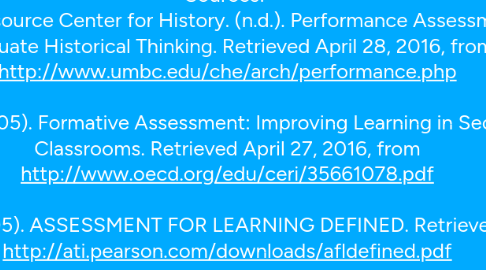
1. Diagnostic: Purpose: To determine where students are at and what changes need to be made to improve learning the content.
1.1. Example: KhanAcademy-- or similar computer-generated programs which are differentiated to test students' strengths and weaknesses. In high school history, I have yet to figure out an appropriate example.
1.1.1. Pros: Quick data which can be used to adapt lessons to students' needs.
1.1.2. Cons: Assessment rarely includes differentiation for different types of learners.
1.2. This is an assessment FOR learning, as it can be used to direct the learning-- highlighting what students already know and what needs work.
2. Formative Purpose: Used to determine what students are learning to adjust the instruction, to ensure students better learn the objectives.
2.1. Example: Teacher asks for thumbs up or thumbs down to check for understanding during a mini-lecture of the Battle for Saratoga.
2.1.1. Pros: Can be implemented whenever and wherever the teacher needs. Allows for frequent teacher and student monitoring.
2.1.2. Cons: Can slow down and stall unit pacing. Students may not accurately respond for lack of interest or false confidence.
2.2. This is an assessment FOR learning, as it can be used to direct the learning-- highlighting what students already know and what needs work.
3. Summative Purpose: Assess whether students have learned the unit/quarter/semester objectives.
3.1. Examples: Unit test over the Declaration of Independence.
3.1.1. Pros: Standard way of ending a unit. Procedure is easy and known. Gives a sense of finality.
3.1.2. Cons: Stress and test-takers anxiety. Final assessment, few opportunities to correct holes in learning.
3.2. This is an assessment OF learning as it covers what the student should have learned over a certain block of time.
4. Performance-based Purpose: Tasks-based application of knowledge.
4.1. Example: http://www.umbc.edu/che/arch/performance.php
4.1.1. Pros: Students solving real problems and interacting with sources.
4.1.2. Cons: Evaluation needs to be specific and other aspects need to be evaluated, such as participation, shared responsibility and other social situations, particularly in group work.
4.2. This is an assessment OF learning based on the students' ability to complete the task assigned to them.
5. High Stakes Purpose: Stress. (Just kidding!) To assess where students place in comprehension of standards in comparison to students around the state/country in the same grade.
5.1. Example: Students take the IOWA tests once a year in October, and high school seniors take the ACT or SAT in the spring.
5.1.1. Pros: Fun (for some). Baseline data to compare student learning.
5.1.2. Cons: Stressful (for most). Over used. Doesn't account for different learning styles. Students don't always care about results.
5.2. This is an assessment OF learning to see where students are doing in comparison to their peers.
6. Portfolio Purpose: Collect student work to show learning over the course of the semester.
6.1. Example: Students contribute projects, essays and feedback throughout the unit on current events to show parents during their parent teacher conferences.
6.1.1. Pros: Fosters student-centered learning. Allows for different learning styles and methods.
6.1.2. Cons: If students slip behind, it may be hard to catch them up.
6.2. This is an assessment OF learning as it shows progressive student achievement.
7. Authentic Purpose: Apply knowledge to 'real world' scenarios.
7.1. Example: Student uses primary sources to make an argument. (In history, paper writing/thesis making is as real world as it comes). Or, applying the Constitution to a mock trial.
7.1.1. Pros: Shows learning is relevant. Allows students to apply what they have learned.
7.1.2. Cons: Teaching students to use the tools they will need (finding sources, using sources, technology, etc) will take time away from other things.
7.2. This is an assessment OF learning based on the students' ability to apply knowledge they have already learned.
8. Self-Assessment Purpose: Student evaluates his/her own work to determine how they are doing and reflect on work.
8.1. Example: Student records his/her presentation and evaluates it using a self evaluation rubric.
8.1.1. Pros: Gives students opportunity for self-reflection. Promotes responsibility for learning.
8.1.2. Cons: Students aren't always honest. Students must be familiar with the requirements and process.
8.2. This is an assessment FOR learning as requires students to evaluate and change their work.
9. Peer-Assessment Purpose: Helps familiarize students with the work of their peers and grading criteria.
9.1. Example: Students complete grading rubrics for peer's presentation.
9.1.1. Pros: Builds camaraderie. Students can reflect on their own work while evaluating others.
9.1.2. Cons: Requires teaching students to evaluate effectively. Student feedback not always 'useful' or 'helpful'.
